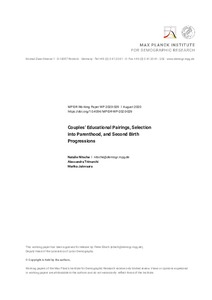Couples’ educational pairings, selection into parenthood, and second birth progressions
Marika Jalovaara; Natalie Nitsche; Alessandra Trimarchi
https://urn.fi/URN:NBN:fi-fe2021042826034
Tiivistelmä
Educational pairings, in other words the combination of educational
levels of both partners, have been shown to have meaningful implications
for couples’ childbearing behavior. Specifically, in a variety of
developed countries, second birth transition rates appear to be higher
among homogamous highly educated couples than among heterogamous couples
consisting of one highly educated partner and one lower educated
partner. However, the mechanisms that underlie these findings are not
well-understood. We extend this literature by proposing and testing
three potential mechanisms. We investigate whether differentials in
second birth rates by educational pairing are, first, an artefact
created by overly broad education categories, which mask that these
differentials are driven by ‘low pooled resources’ or ‘large distance’
couples; or, second, driven by the educational upgrading processes of
the partners; or, third, due to unobserved heterogeneity among couples.
Using data from Finnish registers, we indeed find that second birth
rates are higher as the pooled resources of couples increase. However,
we also find that differentials among the higher educated couples hinge
upon ‘low pooled resources’ couples; meaning that the partner’s
education matters in predicting the risk of a second birth transition
mainly if the partner has low tertiary education. Furthermore, we show
that adding a common term across birth episodes to address unobserved
heterogeneity renders most pairing differentials among the higher
educated groups insignificant, while pairing differentials remain large
and significant among the lower educated groups.
Kokoelmat
- Rinnakkaistallenteet [19207]
